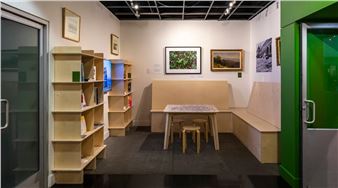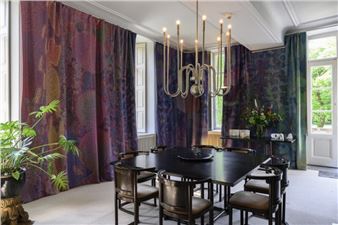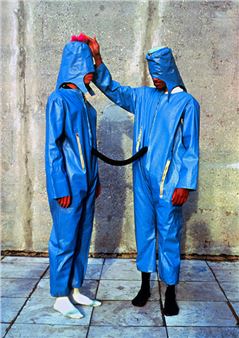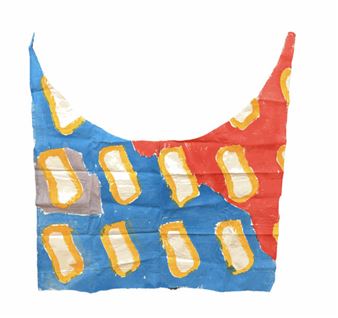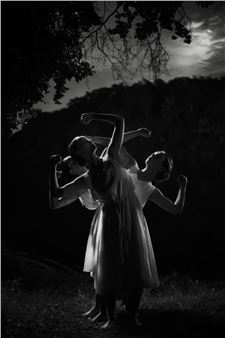100 Years of Bauhaus: Roman Clemens from the Collection
The year 2019 marks the centenary of the founding of the Bauhaus. We would also like to celebrate this anniversary at Museum Haus Konstruktiv, so we are devoting a solo exhibition to former Bauhaus student Roman Clemens (1910ÔÇô1992) from our own collection. Selected paintings from the 1970s and 1980s are on display, supplemented by archive material that has never been made public before, from our part of the artistÔÇÖs estate.
The multifaceted oeuvre of Roman Clemens comprises stage sets, architecture, design and painting. He discovered the central themes of his work (stage and space) at the Bauhaus in Dessau, where he attended classes by Josef Albers, L├íszl├│ Moholy-Nagy, Wassily Kandinsky, Paul Klee, Ludwig Mies van der Rohe and Oskar Schlemmer. Here, already in the late 1920s and early 1930s, Clemens worked out the fundamentals of his later work as a scenographer and painter: His stage space was to be a space full of tension and action, but which, from the audienceÔÇÖs perspective, would also have the qualities of a well-composed painting.
After working as an assistant stage designer at Friedrichs-Theater in Dessau, Roman Clemens transferred his principles to the stage at the Zurich City Theater (todayÔÇÖs Zurich Opera House), where he worked from 1932 to 1943 as stage designer and art director. Together with architect Werner Frey in 1948/1949, he realized the interior design and fittings for what was then Studio 4 (todayÔÇÖs Filmpodium). To this day, it is still probably his most impressive spatial artwork: an ÔÇ£optical cabinetÔÇØ with a design completely defined by the film medium ÔÇô by the contrast between static and dynamic, light and dark, black and white.
In the mid-1950s, Roman Clemens made painting his main profession. The exhibition at Museum Haus Konstruktiv clearly shows that he always considered painting to be related to space. In the selection of paintings from the 1970s and 1980s shown here, Clemens developed abstract geometric image spaces by means of variety-rich field structuring and color organization. The paintings, most of which were generously donated to Museum Haus KonstruktivÔÇÖs collection by the Lis and Roman Clemens Foundation, are supplemented by archive material that also comes from our part of the artistÔÇÖs estate. This includes draft stage designs from ClemensÔÇÖs time at the Bauhaus and City Theater, as well as photographs and documents in the context of his work as director and designer of numerous didactic exhibitions.
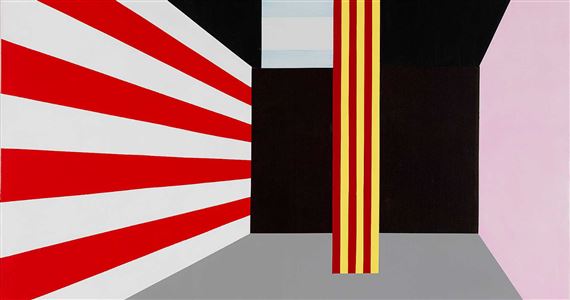
Recommended for you
The year 2019 marks the centenary of the founding of the Bauhaus. We would also like to celebrate this anniversary at Museum Haus Konstruktiv, so we are devoting a solo exhibition to former Bauhaus student Roman Clemens (1910ÔÇô1992) from our own collection. Selected paintings from the 1970s and 1980s are on display, supplemented by archive material that has never been made public before, from our part of the artistÔÇÖs estate.
The multifaceted oeuvre of Roman Clemens comprises stage sets, architecture, design and painting. He discovered the central themes of his work (stage and space) at the Bauhaus in Dessau, where he attended classes by Josef Albers, L├íszl├│ Moholy-Nagy, Wassily Kandinsky, Paul Klee, Ludwig Mies van der Rohe and Oskar Schlemmer. Here, already in the late 1920s and early 1930s, Clemens worked out the fundamentals of his later work as a scenographer and painter: His stage space was to be a space full of tension and action, but which, from the audienceÔÇÖs perspective, would also have the qualities of a well-composed painting.
After working as an assistant stage designer at Friedrichs-Theater in Dessau, Roman Clemens transferred his principles to the stage at the Zurich City Theater (todayÔÇÖs Zurich Opera House), where he worked from 1932 to 1943 as stage designer and art director. Together with architect Werner Frey in 1948/1949, he realized the interior design and fittings for what was then Studio 4 (todayÔÇÖs Filmpodium). To this day, it is still probably his most impressive spatial artwork: an ÔÇ£optical cabinetÔÇØ with a design completely defined by the film medium ÔÇô by the contrast between static and dynamic, light and dark, black and white.
In the mid-1950s, Roman Clemens made painting his main profession. The exhibition at Museum Haus Konstruktiv clearly shows that he always considered painting to be related to space. In the selection of paintings from the 1970s and 1980s shown here, Clemens developed abstract geometric image spaces by means of variety-rich field structuring and color organization. The paintings, most of which were generously donated to Museum Haus KonstruktivÔÇÖs collection by the Lis and Roman Clemens Foundation, are supplemented by archive material that also comes from our part of the artistÔÇÖs estate. This includes draft stage designs from ClemensÔÇÖs time at the Bauhaus and City Theater, as well as photographs and documents in the context of his work as director and designer of numerous didactic exhibitions.
Artists on show
Contact details


 ARTISTS
ARTISTS










